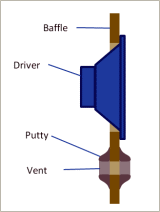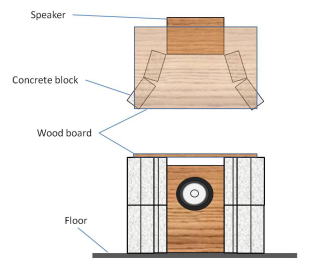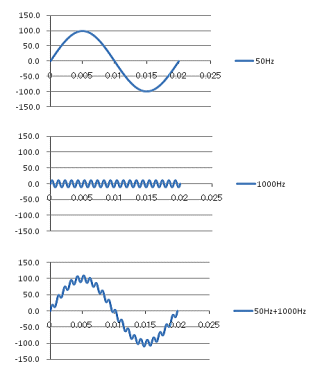Discussion
2011/04/03 created
2021/05/03 updated
The contents of this page were reprinted from the previous homepage of mine, 'Tonochi's Audio Room'. Some parts were edited.
The configuration of an audio system largely depends upon the type of the loudspeaker. First of all, I began with consideration on the type of the loudspeaker.
I decided the target specs: frequency range: 30Hz-40kHz, and sensitivity: 95dB/W(1m). That specs enables reproduction of the lowest sound of any musical instruments; and it covers the bandwidth of analog records.
Wide bandwidth does not always lead to high sound quality, though, I thought all the sounds recorded on discs should be reproduced. I want to avoid cutting off very low and high frequencies due to limitation of the audio system.
Low sensitivity speakers are heavy load for amplifiers. For example, if sensitivity decreases by 3dB, the amp's output power must be doubled, and that makes the current that passes through cables and terminals 1.4 times. Then very low resistance of the cables and terminals must not be ignored. The higher sensitivity, the better sound quality, I believed.
Single Full-range Unit Speaker
First of all, I considered the simplest speaker system that consists of a single full-range driver (single cone type) and an enclosure.
In 1974, many domestic and oversea manufacturers were supplying full-range drivers, and plenty of models were available. But none of them met my requirements. Nevertheless, I decided to give more consideration to loudspeakers that use a full-range driver, because I preferred simple equipment and had been using full-range drivers like Fostex FE103 and Altec 403A since I took up building audio equipment at age 14.
What size of full-range driver is best? The larger, the better in reproduction of low frequencies. But, it seems to me, coloration is strong. This is probably because the larger driver has the narrower piston frequency range and the wider upper frequency range, in which distortion increases.
Later I learned that the theoretical upper limit of the piston frequency range fp[Hz] is given by
fp[Hz] = 5400/a[cm]
where a is the effective radius of the diaphragm. According to the formula, fp of a 16cm/6.5" driver is around 1,700Hz. It is rather low, isn't it? I believe the size of the driver should be 10cm/4" or smaller, if you want to build a Hi-Fi audio system.

The full-range drive-unit, Fostex FE103 (10cm/4" single cone), which I was using in those days, had a very clear sound. I often thought it would have been a perfect speaker if it had had extended lows. So I prototyped some types of enclosures to make sure if I could get extended lows with the drive-unit.
Closed box
I made a relatively large box (approx. 10l) and mounted FE103 to it. The
frequency response in the low range forms a gentle slope, so you should
feel the volume of lows is not enough. But the speaker has extended low.
You can compensate the lack of bass by using the tone control of the amp.
I tried it.
It turned out to be no good. Though it sounded good at low volume, the
sound was distorted at high volume. In this way, the amplitude of diaphragm
is so large that amplitude modulation distortion increases.

Vented Box (Bass Reflex)
I made a vent on a relatively small enclosure I had made at age 14, by
making a 20mm hole and applying putty around the hole. The resonance frequency
must have been very low, though I was not able to measure it precisely.
The result was no good. I couldn't see any improvement about low frequencies.
In those days, I didn't know much about bass reflex. I gave up.

Front Horn
It takes much time and labor to build a genuine front horn speaker. I put concrete blocks in front of the speaker to make something like the front horn.

This tentative horn was a little effective in producing bass, and surely
improved sensitivity. I was kind of satisfied with it, and used it until
I built a polyspeaker system in 1976.
I didn't plan to build a real horn. A horn woofer is usually large, since
it can't provide frequencies lower than its cutoff frequency, and the cutoff
frequency depends on the size of the horn. My room was not spacious (13.2m2)
to install the horn woofer.
By the way, backload horn speakers (BH) designed by Tetsuo Nagaoka caused
a great sensation in those days. I read an article in a magazine about
BH using FE103. It said the speaker could produce deep bass. "Isn't
it great!," I said to myself.
I went to Akihabara to listen to the speaker with a heart filled with excitement.
The speaker was being demonstrated at an audio shop. I listened to it.
Then I was very disappointed, because no deep bass came from it.
I think the size of the horn was too small. And BH lets the sounds from
the back of the drive-unit leak through the horn. Those leaked sounds interfere
the sounds from the front, and cause distortion. I felt the merits of FE103
were spoiled.
Since then, I haven't thought about building BH.
Speaking of horn speakers, there is a show room of YL Onkyo at Akihabara in those days, and its all horn system was being demonstrated. I visited the show room to listen to the system several times. It was the horn super woofer that really fascinated me with its super bass like a rumbling of the ground (it was felt rather than heard). The length of the horn was about 7-8m, and the opening mouth was as big as four grown-ups could enter it.
Consideration to full-range drivers
I reached the conclusion that I would not be satisfied with a speaker using
a single full-range driver.
Five years later, I was more convinced of the conclusion. I read in a book
that small full-range drivers have a big problem in principle. It is frequency
modulation distortion caused by Doppler effect. The large displacements
of the small driver in low frequencies frequency-modulate higher frequency
outputs. For example, when a large signal of 50Hz and a small signal of
1kHz are mixed, a small vibration of 1kHz is superposed on a large displacement
of 50Hz. The position of the sound source for the 1kHz signal moves forward
and backward at the pitch of 50Hz, and the 1kHz signal sounds like a vibrato.
This distortion is almost not sensed with a source that contains less harmonics
like a solo of acoustic guitar. On the other hand, with a source that contains
much harmonics like a performance of an orchestra clarity is degraded.
I regard this problem seriously since it is impossible to solve it technologically.

Two-way Speaker System
I didn't spend much time to consider two-way speaker system, because combination
of drive-units is limited for a two-way speaker system.
If you select a large woofer expecting a good low frequency response, fc
(crossover frequency) should be 1kHz or lower. Almost all tweeters of which
frequency range is 1kHz-40kHz or wider are dome tweeters. The sensitivity
of a dome tweeter tends to be low, so there's a possibility that its sensitivity
is lower than that of the woofer. Though sensitivity is not a problem in
a multi-amp system, I'd rather choose a three-way or a four-way system
if I would build such a complicated system at all.
Consequently, I didn't choose the two-way speaker system.
Three-way speaker system
A three-way speaker system probably satisfies my requirements. It would cost much, though, I regarded it worth challenging.
For multi-way speakers, there are two configurations: 1) the network is placed before the power amps (multi-amp system), and 2) the network is built in the speaker (LC network). Manufactured loudspeakers, with few exceptions, are the latter. For home-built speakers, you can choose either way.
Problems of LC Network (Passive Network)
An LC network consists of L (inductor) and C (capacitor), and divides the input signal into some frequency ranges. The LC network is usually built in the enclosure. This method has some problems.
An LC passive filter, which is designed correctly according to formula, doesn't work as designed, because the impedance of the speaker is not constant; it substantially varies with frequency. And it is difficult to realize a sharp cutoff filter by using only passive components like L and C. So the frequency ranges are overlapped to a considerable degree. It is not desirable as a network.
Every electronic component has resistance to dissipate power. L and C, too, have resistance. Besides, attenuators are necessary to flatten out the frequency response as each driver has different sensitivity. The attenuators consist of resistors (R). R is resistance itself and dissipates power. In other words, some of power supplied by the amp is consumed before reaching the drivers. I believe the loss of power affects the sound quality.
Mechanical vibration applied to any electronic component causes distortion and/or noise. Especially, C is so sensitive to vibration that it can be used as a microphone element. The network built in the speaker enclosure is directly affected by the vibration from the drivers.
To solve these problems, expensive parts, complicated circuits, and special materials are needed. An ideal network might cost as much as a multi-amp system.
Advantages of the multi-amp System
In the multi-amp system, a network called a channel divider is placed between the preamp and the power amps; the signal is divided to the low, mid and high frequency ranges before the power amps. Each of the drive-units (woofer, midrange and tweeter) is driven by the dedicated power amp.
The most advantageous point of the multi-amp system is a wide choice of the filters for the network. Active filters with a sharp cutoff such as -18dB/oct or -24dB/oct may be used. Of course, a -6dB/oct passive filter can be used too. It is possible to implement a switch that switches the characteristics of the filter including fc.
The second advantageous point is combination of driver-units regardless of sensitivity. For a single amp system, the sensitivity of the tweeter must be higher than that of the woofer. For a multi-amp system, there's no such limitation; the combination of a woofer with high sensitivity and a tweeter with low sensitivity is acceptable. Generally, larger woofers tend to have higher sensitivity. The multi-amp system is desirable if you choose a large woofer, as you definitely have a wide choice of tweeters and midranges.
Another advantage is unnecessariness of attenuators in the speaker system. Among horn tweeters, there are ones with sensitivity of nearly 110dB/W. There is a possibility that the sensitivity difference between the tweeter and the woofer/midrange turns out to be nearly 20dB. Attenuation as much as 20dB obviously has a bad influence to the sound quality.
In addition, there are some more advantages: reduction of IM distortion of the power amps, increase in actual maximum output power of the power amps, etc.
Disadvantage of multi-amp System
multi-amp systems are expensive since as many power amps as drivers are necessary. However, you can build the system at lower cost if you design the amps and loudspeaker special for the multi-amp system, compared to the system that consists of products of manufacturers.
Conclusion
I came to a conclusion that I should build a three-way multi-amp system with a large-sized woofer that can produce 30Hz output, and a horn tweeter and a horn midrange, which have high sensitivity. I decided to build all the amplifiers on my own, and make the spec of the power amplifiers specialized to the characteristics of the loudspeaker. Also I decided to build the loudspeaker on my own, which does not include the network and attenuator as it is specialized to the multi-amp system.